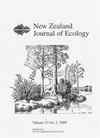新西兰奥特罗阿丰盛湾鲸鱼岛燃烧概率图
IF 1.4
3区 环境科学与生态学
Q3 ECOLOGY
引用次数: 2
摘要
新西兰的保护管理一直非常关注近海岛屿,尽管这种投资面临着生物安全入侵和野火等人为因素的风险。在上个世纪,丰盛湾的鲸鱼岛发生了几次野火,这里是六种濒危植物和三种濒危动物的栖息地。在过去的几十年里,穆托霍伊岛的保护和文化管理使其恢复为人类到达之前植被最茂密的岛屿,尽管其组成与人类大相径庭。利用Prometheus火灾增长模拟模型,生成了一系列确定的火灾范围图,并将其编制成季节燃烧概率图。平均模拟火场面积为53.2公顷,最大面积为129.9公顷(约为1公顷)。占全岛的84%),23%的火灾面积不超过0.01公顷。夏季开始的火灾,岛的西端,mānuka和/或kānuka有最高的平均和最大的火灾范围。燃烧概率图是量化诸如穆托霍拉等重要保护区空间火灾风险的关键步骤。本文章由计算机程序翻译,如有差异,请以英文原文为准。
Burn probability mapping of Moutohorā (Whale Island), Bay of Plenty, Aotearoa New Zealand
: Aotearoa New Zealand’s conservation management has had a strong focus on offshore islands, though this investment is at risk from human-influenced factors such as biosecurity incursions and wildfire. During the last century several wildfires have occurred on Moutohorā (Whale Island), Bay of Plenty, which is a location for six threatened plant and three threatened animal species. Conservation and cultural management on Moutohorā over the last several decades has restored the island to become the most densely vegetated it has been since before humans arrived, albeit with a very different composition. The Prometheus fire-growth simulation model was used to produce a series of deterministic fire extent maps, which were compiled into seasonal burn probability maps. The average simulated fire extent was 53.2 ha, with a maximum area of 129.9 ha (or approx. 84% of the entire island), with 23% of fires not growing past 0.01 ha. Fires that start in summer, the western end of the island, and in mānuka and/or kānuka had the highest mean and maximum fire extent. Burn probability maps are a key step in quantifying the spatial fire risk for important conservation locations such as Moutohorā.
求助全文
通过发布文献求助,成功后即可免费获取论文全文。
去求助
来源期刊

New Zealand Journal of Ecology
环境科学-生态学
CiteScore
3.00
自引率
12.50%
发文量
35
审稿时长
>36 weeks
期刊介绍:
The New Zealand Journal of Ecology is a biannual peer-reviewed journal publishing ecological research relevant to New Zealand/Aotearoa and the South Pacific. It has been published since 1952 (as a 1952 issue of New Zealand Science Review and as the Proceedings of the New Zealand Ecological Society until 1977). The Journal is published by the New Zealand Ecological Society (Inc.), and is covered by Current Contents/Agriculture, Biology and Environmental Science, GEOBASE, and Geo Abstracts.
 求助内容:
求助内容: 应助结果提醒方式:
应助结果提醒方式:


